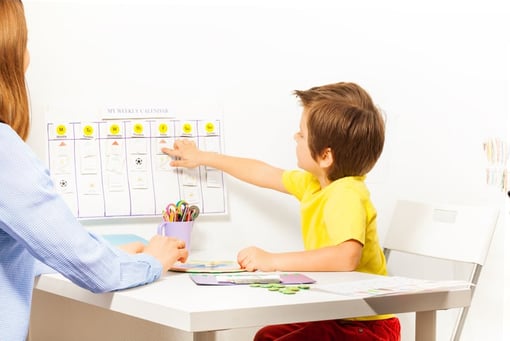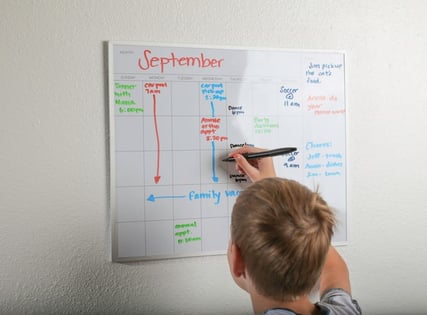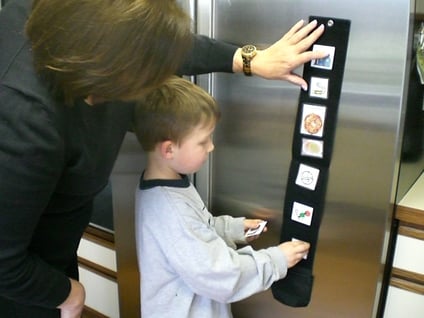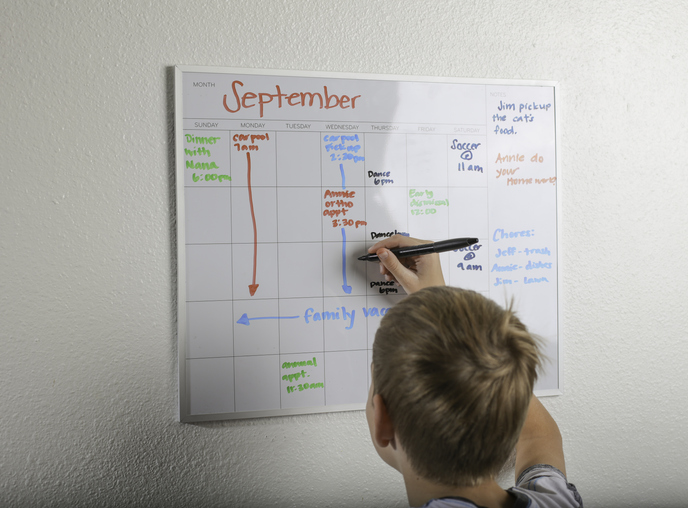A Guide to Types of Visual Schedules for Autistic Individuals
Personalization Is the Key
You have probably heard a lot about using "visual schedules" for autistic people. However, you may not be as familiar with the many different types of visual schedules or the different factors that need to be considered when creating one that is individualized to a particular person's needs. The following article provides a quick and simple introduction to the variety of visual schedules that can be used and how to distinguish between their uses.
Visual schedules represent the activities in a person’s day or a part of their day. They explain what will happen, where, and in what sequence. The benefits of visual schedules for autistic people are numerous. A main benefit is they help individuals access “executive functioning” skills- being able to plan, organize, and carry out tasks. They also help establish routines, reduce anxiety, and can even teach flexibility.
Types of Visual Schedules
There are different types of visual schedules:
- Object schedules
- True Object Based Icons (TOBI) schedules
- Photo schedules
- Picture schedules
- Written schedules

Object and TOBI Schedules
Object schedules work well for concrete learners, as they use literal objects arranged in a sequence. The objects can be items that the person will use for the activity (a pencil for a writing activity) or they can be objects that represent the activity to them (a small rubber ball to represent gym class).
The schedule can be presented in many different ways, depending on what makes the most sense to the user. For example, the objects can be laid out in a horizontal row on top of colored trays on a table, or they can be housed vertically in small boxes or on a bookshelf.
TOBI schedules exist as a middle ground between object schedules and representative pictures. These schedules are typically photos of real objects, cut out to represent the real shape of the object. This is useful for individuals who are still concrete learners but may be unable to use an object schedule or understand a photo schedule.
Photo and Picture Schedules
Photo schedules use real-world photographs to represent activities. These can be photos of the actual places and/or objects the person will use, or they can be generalized representative photos, depending on the user’s understanding. They can also be photos of the person themselves engaging in the activity.
Picture schedules are what probably first comes to mind when you think of "visual schedules," as they are commonly seen and used. However, it is important to not consider a picture schedule as the default, as it may not be the best support for every person.
Picture schedules use line drawings and representative images of activities - these can be Picture Exchange Communication System (PECS) images, more general clipart, or specially made images. It depends on what the person enjoys and understands. The visuals can also be drawings done at the moment by a support person if the autistic individual understands them.
Written Schedules
Written schedules are those that use the written word, which is still visual! How activities are written depends on the individual’s reading level, processing ability, and level of comfort. A written schedule may look like a typical timetable for a school schedule or a checklist of activities in a person’s day. Usually, written schedules are crossed or checked off, although they can also be marked as complete in other ways. Depending on the person’s preference and understanding, the activity can be marked off before or after they complete the activity itself.
 When you create a visual schedule, remember it does not have to be with only one type of visual. You can mix and match these different representations depending on what makes the most sense to the individual using the schedule.
When you create a visual schedule, remember it does not have to be with only one type of visual. You can mix and match these different representations depending on what makes the most sense to the individual using the schedule.
For example, you can use a photo schedule with written words underneath the photos. Or you can use a schedule that has photos for some activities and objects for other activities that the person needs to have represented more concretely.
The type of schedule the individual has should be what is usable for them even on their hardest day. For instance, maybe they can read very well, but when they are overwhelmed by demands or the environment they prefer having pictures, as it takes less processing energy. In that case, you can use words and pictures together.
The point of using visual schedules is not to “move up” a hierarchy of schedules, from concrete to more abstract. Rather, the point is to always use the support that is most useful for the person.
Considerations for Visual Schedules
There are many other things to consider when making individualized schedules, such as:
The schedule's:
- Length
- Location
- Mode of manipulation
and
The individual’s:
- Attention span
- Motor skills
- Organizational skills
- Processing abilities
- Sensory needs
A Schedule's Length
A schedule's length should be based on:
1) What makes sense for the individual, dependent on how they conceptualize time or see their day. They may make the most sense out of a First-Then schedule or they may understand the entire day or a half day better.
2) What causes the least amount of anxiety for the individual. For some people, having too little information causes anxiety, while for others having too much information will cause anxiety.
3) What length of the information is easiest for them to process, depending on factors like their attention span or distractibility.
A Schedule's Location
The location of the schedule is another important factor. Sometimes a schedule can move around with the individual. They may carry it themselves or a support person may carry it for them. The individual might carry the schedule and keep it on them at all times or they might carry it and place it in a designated spot at each location. Sometimes the schedule should always stay in one place, such as taped on the wall in a particular area. The individual then transitions back to where the schedule is kept after each activity to see what activity is next.

A Schedule's Mode of Manipulation
There are many modes by which a visual schedule can be manipulated. Some schedules have minimal manipulation. The schedule may be relatively fixed and stays the same each time the person uses it, so the person may only check off or cross off activities as they finish them. This can typically be done with a pencil or marker.
For some schedules, the visuals are tactile and can be actively manipulated. The schedule might change often from day to day. The individual can make the visuals disappear by placing them in a “Finished” pouch or they can move the visuals over to a “Done” column. This is also useful for concrete visual, tactile, and/or kinesthetic learners.
Another method is that the person might match visuals to an area where they will engage in the activity. This method is helpful for individuals who will get distracted during transitions. Once the visual is placed in the area with the current activity, they know what to engage with next.
An Individual's Needs
Visuals can be made with velcro or magnets, placed in pockets, or affixed to the schedule in another way, such as with paper clips. It is a good idea to consider the individual’s sensory needs when creating a schedule. For example, they might find the sound or feeling of velcro to be very unpleasant. Or they may find the sound and feeling of placing a magnet to be very satisfying.
It is also important to consider their motor skills. It may be difficult for some individuals with poor fine motor skills to pick up and move the visual pieces if they are made of a certain material or cut to a certain size. Small adjustments can make a big difference in the person’s ability to use the schedule competently and happily.
There are countless ways schedules can be presented and manipulated, so it depends on assessing a variety of skills and preferences of the individual to figure out the best approach. When thinking about using visual schedules, it is important to refer to a professional who is experienced in differentiating types of schedules and who can assess your child's unique cognitive and sensory profile.
Is there a particular type of schedule that works best for you or the autistic person in your life?

Christa Mullis
Christa Mullis is an Autism Accessibility Specialist and educational coach for teens and young adults on the spectrum. She is also the founder of Spectrumize: Organization for Autism Accessibility (https://spectrumize.net/), where she helps families, educators, and community members create homes, classrooms, and public spaces that are accessible and accommodating to autistic individual’s unique strengths and needs. Christa received her Master’s degree in Educational Development with a focus in Special Needs and Inclusive Education from Hiroshima University’s Graduate School of International Development and Cooperation. She has worked with autism communities around the world and hopes to continue making positive changes in recognizing the strengths of autistic children and creating a more welcoming world for them to thrive.




